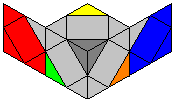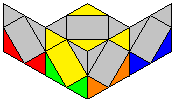Sarah's Method
Printable VersionThis is the method I created to solve a skewb.
- Notation & Algs
- Beginner's Variation
- Intermediate Variation
- Advanced Variation
For simplicity, I'll be using this notation:
"L" layer 
"F" layer 
"R" layer 
This notation is NOT related to FCN I'll be using this instead of FCN because it's much more convenient to describe the algorithms I use. The x, y, and z rotations will be the same rotations as used in FCN.
My method is based off of two very easy algorithms. They're both four moves, and they are the same as the "sledgehammer" (R' F R F') and the "hedgeslammer" (F R' F' R) on a 3x3x3 cube. Note that F' L F L' is the same as y' R' F R F', and L F' L' F is the same as y' F R' F' R.
I recommend being familiar with these two algorithms, since you're going to be using them a lot. There are lots of ways to grip the skewb to preform them, there isn't a single best way to do it. Also, figure out for yourself whether you prefer the sledgehammer or hedgeslammer, since you can often control which one you do more often.
These are the four steps:
Step 1 – Solve the first side 
Step 2 – Solve the remaining corners 
Step 3 – Solve the U center 
Step 4 – Solve the remaining centers 
The first step is intuitive. Once you become familiar with how the skewb turns, this is an easy step. When you're trying to solve a side for the first few times, the last corner might be a bit tricky. Two-thirds of the time, you will have to take out an already-solved corner in order to solve the last corner. If this is the case, place the corner so that it is in one of the two positions below, and perform the algorithm below it.
 L F' L'
L F' L'
 R' F R
R' F R
The second step is where the 4-movers come in. If the upper corners aren't already solved, you will have one of these two cases.
 F' L F L'
F' L F L'
or
(y2) L F' L' F
 R' F R F' (y) R' F R F'
R' F R F' (y) R' F R F'
or
L F' L' F (y') L F' L' F
The third step is simple enough.
 R' F R F' (y2) R' F R F'
R' F R F' (y2) R' F R F'
or
F R' F' R (y2) F R' F' R
The last step involves the same algorithms used in step 3. Do a (z) or (z') rotation first, to match one of the cases below.
 R' F R F' (y2) R' F R F'
R' F R F' (y2) R' F R F'
or
F R' F' R (y2) F R' F' R
 R' F R F' (y2) R' F R F'
R' F R F' (y2) R' F R F'
(y2 x')
R' F R F' (y2) R' F R F'
or
F R' F' R (y2) F R' F' R
(y2 x')
F R' F' R (y2) F R' F' R
 R' F R F' (y2) R' F R F'
R' F R F' (y2) R' F R F'
(z2 x')
R' F R F' (y2) R' F R F'
or
F R' F' R (y2) F R' F' R
(z2 x')
F R' F' R (y2) F R' F' R
This variation is just like the Beginner's variation, except the second and third steps are combined. These are the steps:
Step 1 – Solve the first side 
Step 2 – Solve the opposite side 
Step 3 – Solve the remaining centers 
The first and third steps are done the same way as in the beginner's variation. There are ten cases for the second step, divided into three categories. The category 2 and 3 cases are eventually reduced to category 1 cases.
Category 1 Cases
 F' L F L'
F' L F L'
 (y2) L F' L' F
(y2) L F' L' F
 (y2)
(F' L F L')2
(y2)
(F' L F L')2
or
(L F' L' F)2
Category 2 Cases
 R' F R F' → cat. 1
R' F R F' → cat. 1
or
(y2) R' F R F' → cat. 1
 R' F R F' → cat. 1
R' F R F' → cat. 1
or
(y2) F R' F' R → cat. 1
 L F' L' F → cat. 1
L F' L' F → cat. 1
or
(y2) L F' L' F → cat. 1
 L F' L' F → cat. 1
L F' L' F → cat. 1
or
(y2) F' L F L' → cat. 1
Category 3 Cases
 R' F R F' → cat. 2
R' F R F' → cat. 2
or
F R' F' R → cat. 2
 (y2) R' F R F' → cat. 2
(y2) R' F R F' → cat. 2
or
(y2) F R' F' R → cat. 2
 (y) R' F R F' → cat. 2
(y) R' F R F' → cat. 2
or
(y2) R' F R F' → cat. 2
or
F R' F' R → cat. 2
or
(y') F R' F' R → cat. 2
This is where it gets a bit crazy. The second and third steps of the intermediate variation are combined into one step.
These are the two steps:
Step 1 – Solve a side 
Step 2 – Solve the rest 
There are 134 cases for the second step. I've organized them into groups based on their "CLL+U center" case. The sledgehammer and hedgeslammer are named S and H respectively, for simplicity, where the sledgehammer is F' L F L' and the hedgeslammer is L F' L' F. The letter in brackets at the end of algorithm indicate which face is at the Front-Left. Green is (g), orange is (o), blue is (b), and red is (r). In other words, (g) indicates no rotation, (o) indicates a (y) rotation, (b) indicates a (y2) rotation, and (r) indicates a (y') rotation. If an algorithm is missing (indicated by an "-"), it's because it takes 5 sledgehammers/hedgeslammers, making it a bit too inefficient. If you intend to learn these seven cases, I suggest learning optimal algs. For the most of the Last 5 Centers cases, it's not very efficient solving them with sledgehammers and hedgeslammers either. For optimal algorithms, check out Meep's skewb page (note: they're written in FCN).
Click on "Printable Version" to view all the cases.